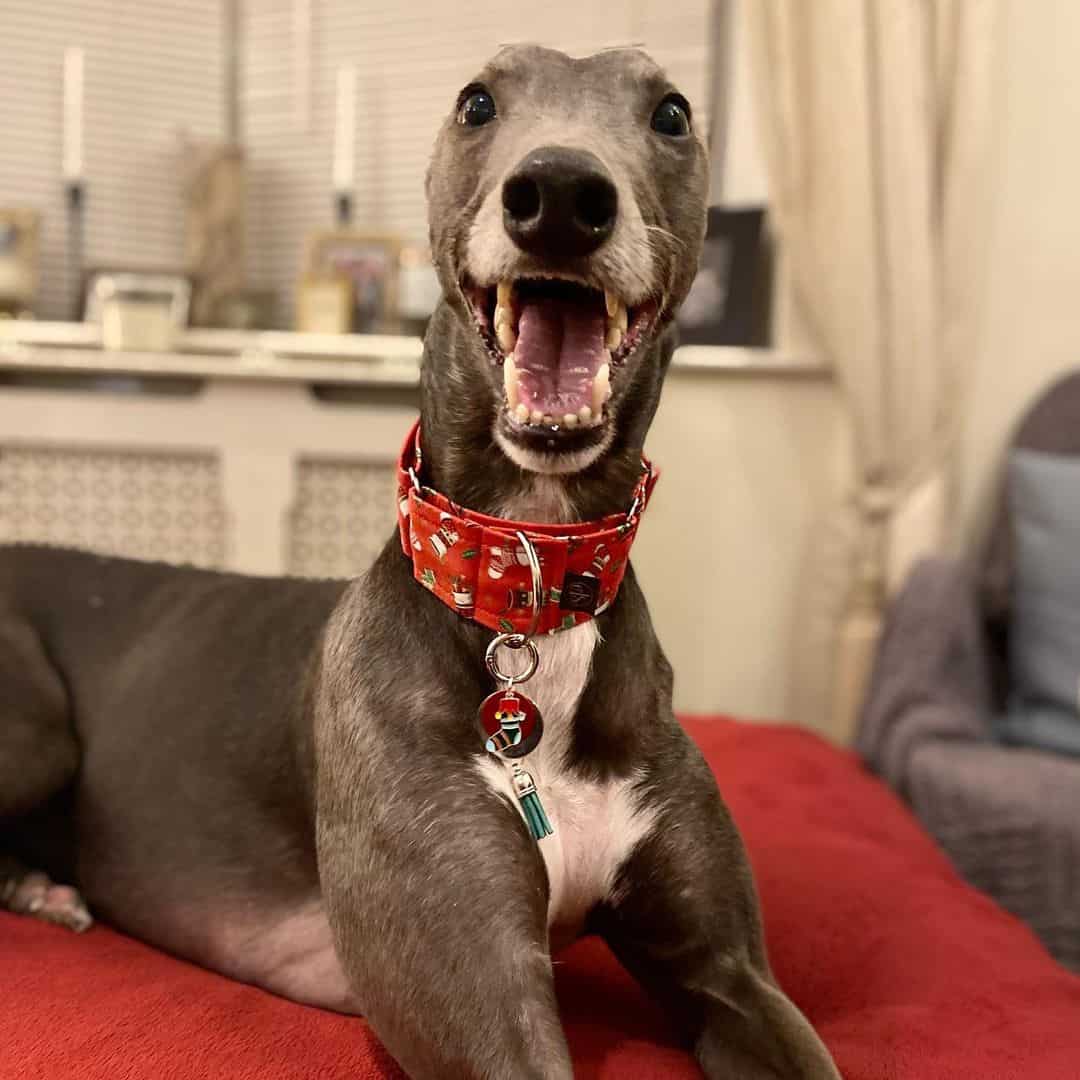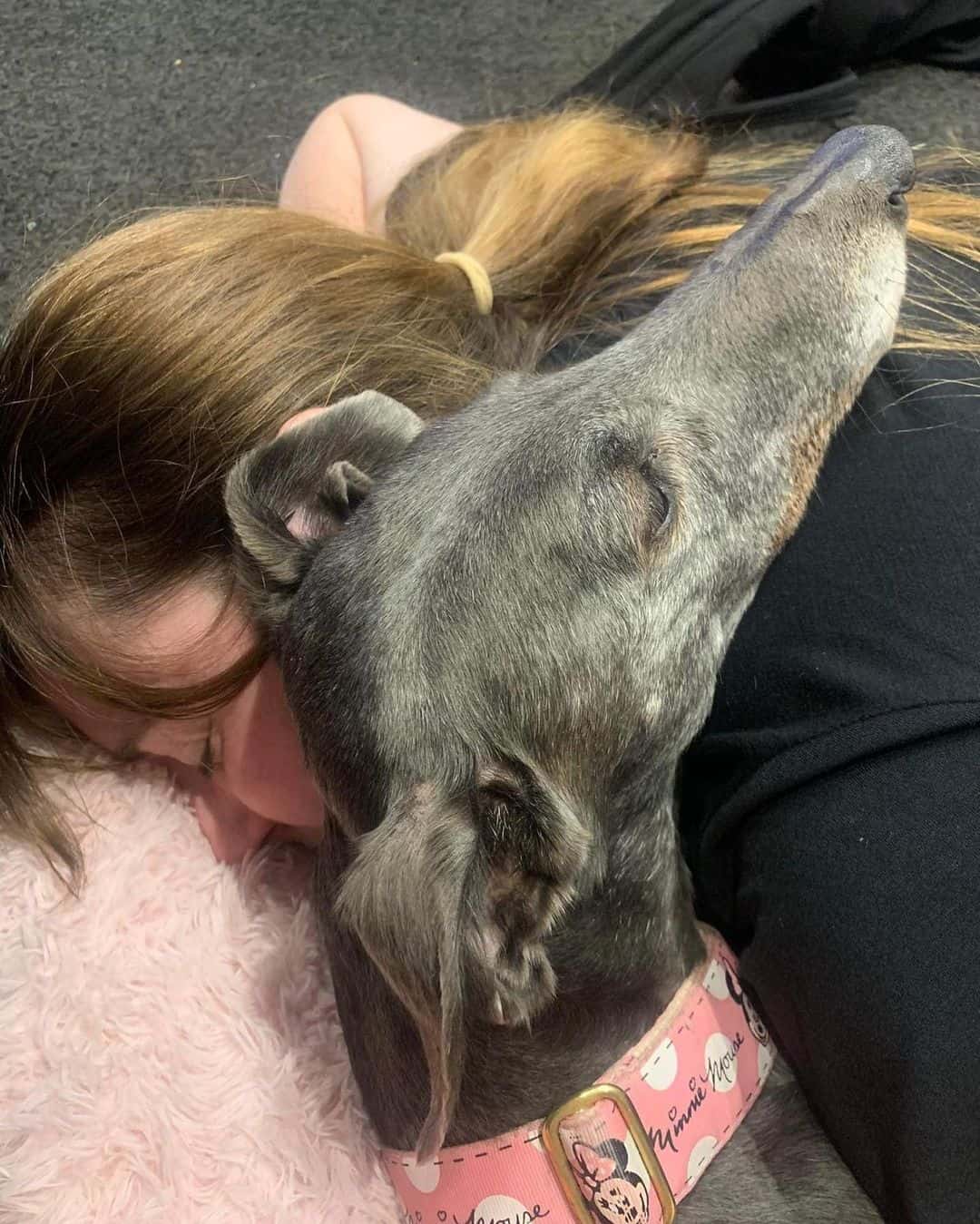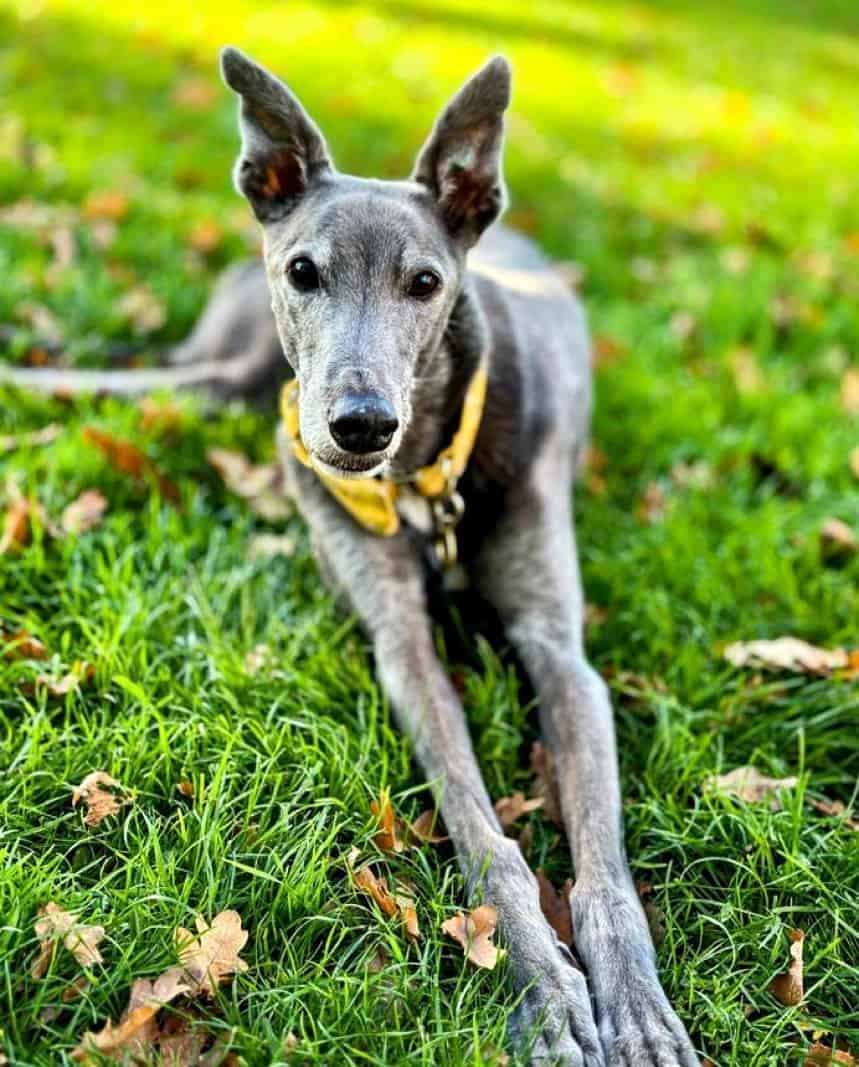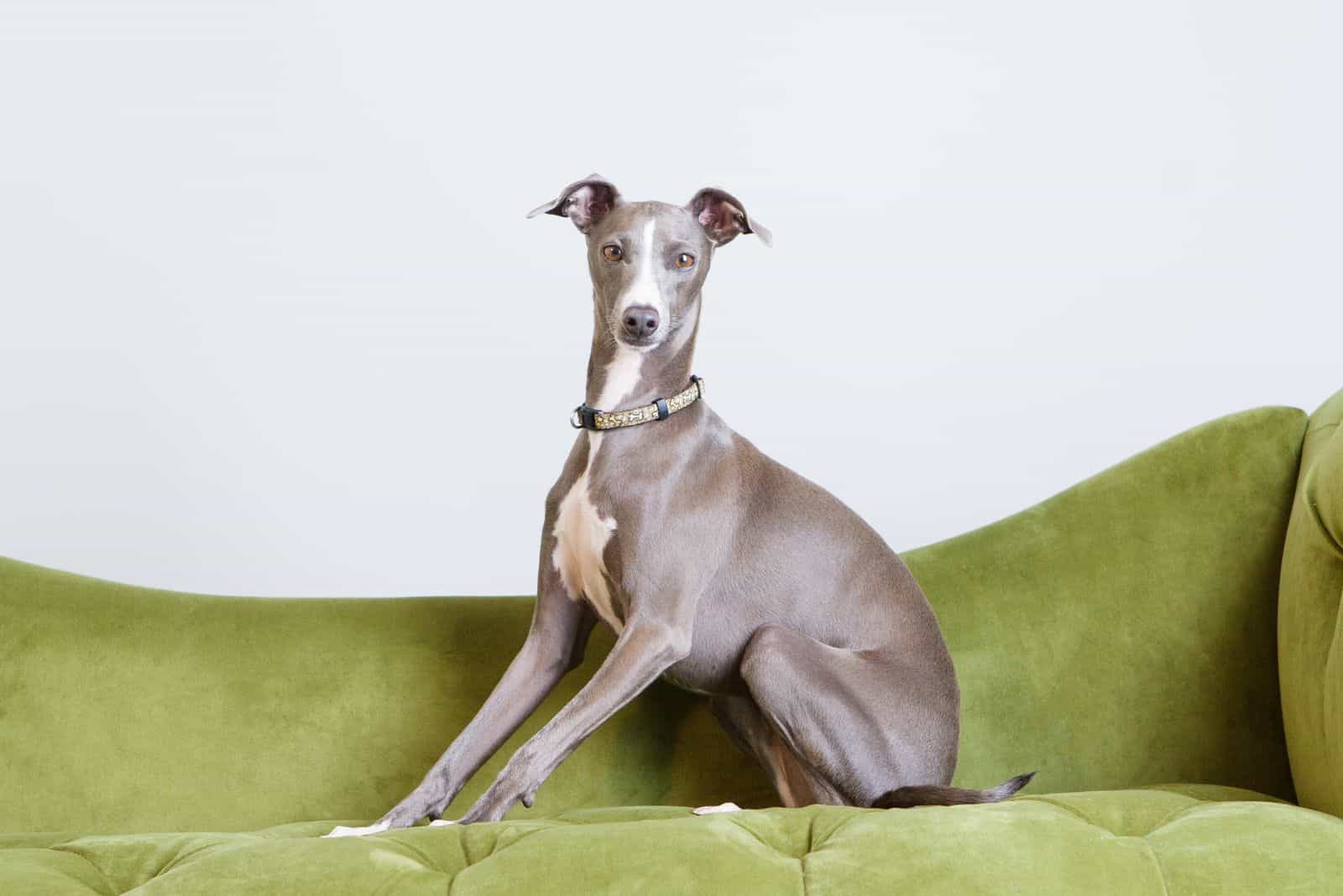They are fast, beautiful, and elegant. These dogs have been an object of fascination and wonder for thousands of years for people across the globe.
They come in a special inverted S shape of their body, which is the signature shape of the sighthounds. And, they come in many coat colors. They can be brindle, black, fawn, and so many other coat color variations. But, what’s the rarest and the fairest of them all? It’s the true blue or smoky-blue color.
Blue Greyhounds are one of the rarest colors in the Greyhound world. It all comes to genes, but we’ll talk about genetics later.
We have to find the answer to the question of what exactly is a blue Greyhound, how did it come to life, and who made it? Of course, the blue Greyhound is a color variation of the standard AKC-accepted Greyhound.
But, what is special about these dogs is that their rarity makes this dog even more beautiful. Everyone wants to have a blue Greyhound pet make heads turn when they go for a walk.
Well, let’s learn more about them, shall we?
What Is A Blue Greyhound?

Once again, the blue Greyhound is not a separate dog breed. It is a color variation of the Greyhound, which means they have the same origin story.
And, that story is…
The Greyhound’s origins go way back to Ancient Egyptian times. Some hieroglyphs look unbelievably similar to the Greyhound dogs we have today. This means that this incredible dog breed has been around for more than 5000 years!
Another dog that has such a long history is the Saluki. It is also a lean and fast dog, but not as fast as our blue boy.
Breeders didn’t use Salukis; they used Greyhounds to make other smaller versions of fast dogs — Whippets and Italian Greyhounds (Iggy), and even Lurchers. They all have that inverted S shape of their body.
The inverted S means that they have a very deep chest, with a waist that is tightly tucked. The entire blue Greyhound’s body is made for running! They have an aerodynamic skull, a deep chest, and thick paw pads to absorb the shock while running.
So, it is only natural that people today use these dogs (blue and any other color) for dog racing called Greyhound racing.
Of course, as you can tell, they were originally bred and used as hunting dogs (today known as a sporting group, by the AKC). They are sighthounds — fast and agile. Greyhounds are quite big, too. They can weigh more than 90 pounds, and stand up to 30 inches tall.
There are even fat Greyhounds! Even though they naturally look slim, they can still put on some extra weight and look kind of chubby.
Now, what does a blue Greyhound look like?
What goes into making such a beautiful coat color?
What Do They Look Like?
Yes, Greyhounds have many coat color variations. But, the blue variant Greyhounds are something different — they truly look beautiful. Just think about other blue dog breeds. Think about the blue Poodle. They look so fancy.
The Blue Greyhound has a short blue coat. It is a single coat with smooth fur that can be in different shades of blue color:
- Deep blue
- Blue brindle
- True blue
- Smoky blue
- Blue fawn
The recessive gene is responsible for each of these versions of the blue coat color. That’s why the blue Greyhound is so rare. What does this mean?
What Makes The Blue Color Blue?
To understand why blue Greyhounds are so rare, we have to take a look at that recessive gene I’ve just mentioned.
There are only 8 genes in dogs that dictate the dog’s coat color. And, on those 8 genes, there are different loci (special places on the genes) that further dictate the coat color.
Our interest is in the D locus. That is the dilute locus.
This is the factor that dilutes the colors, and makes the black color turn into gray, blue, or a very light brown coat color.
There are two types of alleles connected with dilution. They are dominant D and recessive d. For a Greyhound to be a blue Greyhound, it takes two recessive dilution alleles to take action together.
In other words, both parents need to have the recessive gene for their offspring to be blue-colored.
Is The Temperament Of The Blue Greyhound Different?
If you go around and ask pet owners about their dogs, cats, parrots, or even fish — you will find answers like: My parti Poodle is different… she is nothing like the others. Or, an answer like: calico cats are more mischievous than others.
That is something people do and, as you’ve guessed — it’s not a scientific fact. It’s just our way of telling the world how much we love our pets. They are unique to us.
So, a blue Greyhound doesn’t have a different temperament just because it’s blue.
Dogs are a unique mix of genes, and every dog is one of a kind. They have their own personalities, likes, and dislikes. But, the color of their coat has nothing to do with it.
You can have a blue fawn Greyhound or a white Greyhound, but they will share the same temperamental traits that make this breed so interesting and popular.
1. Very Affectionate

Greyhounds are very affectionate with their owner. They like to cuddle and be with you. But, they are not open and friendly with everyone.
You’ll have to keep an eye on your blue Greyhound when there are strangers around. They are not aggressive – they are simply reserved, which can turn into defensive behavior if a stranger keeps bothering them.
If properly socialized from an early age, these traits can turn into indifference, meaning they still won’t be affectionate with strangers, but they will learn not to act defensively.
Besides strangers, Greyhounds need socialization to learn how to behave with children. If you plan on getting a Greyhound and you have children — make sure you get it from a breeder or a Greyhound adoption where people who work there properly socialize dogs.
2. Good With Other Dogs
By being a sighthound, blue Greyhounds (or any other Greyhound) were originally bred to hunt in packs. That makes them good with other dogs.
You won’t have a lot of problems introducing a new dog to your Greyhound, or vice versa. They are pack dogs, and they function well in groups.
But, keep in mind that any pack will have a more dominant dog. That’s how it works. So, don’t get confused if your rescue Greyhound turns out to be the alpha dog and shows such behavior.
3. High Energy Level
As you might have already concluded yourself, Greyhounds need to stretch their long legs daily. You won’t have to go on long walks or hikes — your Greyhound only needs a good run or two to satisfy its high-energy levels.
After that, they will actually love spending time with you on the sofa. So, to sum it up, they do need daily exercise, but they don’t need to exercise for a long time. They belong to the medium-energy dogs group.
4. Not Very Easy To Train
Owning a Greyhound means you will have to be very patient when it comes to teaching them what to do and what not to do. They are smart, but stubborn.
As a sighthound, they are used to doing things their own way. They didn’t rely a lot on people to hunt animals — they chased the animals with other dogs. In other words, they knew what to do.
So, training your new blue Greyhound puppy can be tricky, especially for first-time dog owners. You will need lots of patience and positive reinforcement.
Can The Blue Color Influence The Greyhound’s Health?

Greyhounds are generally healthy dogs. If bred properly and properly taken care of, they will produce offspring that will be just as healthy.
But, the recessive dilute allele we talked about can cause a health problem called Color Dilution Alopecia (or CDA).
This disease’s symptoms can be seen as hair thinning or complete loss of patches of hair. Other symptoms include itchy skin or flaky skin.
This is associated with the dilution gene, and it is common in dog breeds that have blue, fawn, or lilac coat color. This means that the blue Greyhound is prone to this disease.
A dog is not born with these symptoms. They are born with normal-looking skin and fur. The first changes can happen when the dog is about six to seven months old. They can also show up later in life. Some owners have reported that their dogs started losing hair when they were about two years old.
Why Does CDA Happen?
The exact reason behind Color Dilution Alopecia is unknown. What is known is that the dogs with the recessive d allele (or dilution gene) have hair follicles that are not in other dogs. Their hair follicles are not working properly.
That means they don’t have the power to regenerate or regrow hair. That’s why when the dog loses patches of hair, nothing grows back — their hair follicles have no regenerative power; hence, the bald patches.
Is It Life-Threatening?
Luckily, Color Dilution Alopecia is not life-threatening. It won’t harm your dog’s overall health. The only problem can be flaky and dry skin, which can be a good foundation for bacterial infections.
That’s why your veterinarian will prescribe ointments or shampoos to ease the itchiness and help the skin heal. Unfortunately, there is nothing else that can be done. There is no cure for CDA nor is there a “hair-growing” shampoo.
You will have to keep cleaning the bald patches and keep them moisturized in order to prevent any secondary infections. They don’t have to be bacterial – they can be fungal as well.
If it turns out that your dog has a more serious skin infection, then the vet can prescribe oral antibiotics to subdue the infection and help the skin heal.
If the skin is kept clean and there are no infections, your blue Greyhound’s life won’t change a lot. They will still be lean, fast, rooing doggos that make your days a little bit brighter.
Are There Other Diseases?
There aren’t any other diseases connected with the blue color, but there are diseases that are common in Greyhounds (of any color).
A disease called Greyhound polyneuropathy is specific to this dog breed. It is a neurological disease in which degeneration of the peripheral nerves happens, causing weakness, and consequently, atrophy of the muscles.
The first signs of this disease can be seen when the puppy is around three months old. There is no cure for this disease, and eventually, the dog has to be euthanized.
This is inevitable because later, as the disease progresses, they cannot stand up, bark, and eventually breathe as the laryngeal muscles fail.
There are tests available that can be done to prevent further breeding of these dogs. Because this is an autosomal-recessive disease, a dog has to inherit genes from both dog parents in order for this disease to develop.
If you have a blue Greyhound that suffers from this heartbreaking disease, there are places where you can euthanize your dog for free. It is a hard decision, but one that has to be made eventually.
The Conclusion
In the end, I can say that blue Greyhounds are truly wonderful, rare, and beautiful. All Greyhounds have that royal or aristocratic look, but the blue ones have that extra-aristocratic look!
In essence, there are no temperamental or conformation differences between a blue Greyhound and Greyhounds of other coat colors. They all have the inverted S shape of their body, they all have those cute rose-shaped ears, and they all love to run!
There are health issues that are directly connected to the gene that makes these dogs blue — a disease called Color Dilution Alopecia. Besides this, all Greyhounds can suffer from a neurological disease that is connected strictly to this dog breed.
But, you’ll see that having a blue Greyhound means that you have to get used to people stopping you and asking you about this beautiful dog, and where you got it from.
People will want to pet your dog, and they will want to come closer to take a better look, so you will have to properly socialize and train your dog not to react in a defensive way. Start early, when the dog is still just a puppy, and work your way through the years.
Other than that… enjoy and have fun with your doggo!
